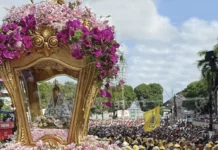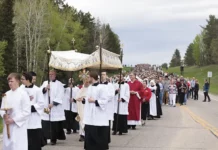New priests ordained in Vietnam
On July 25, thirty-four new Vietnamese priests were ordained. They will be sent as missionaries wherever the Lord calls them to proclaim and witness to the Gospel. “It is a day of great joy, a day of great blessing in the Diocese of Vinh,” commented Bishop Alphonso Nguyen Huu Long, who presided over the ceremony.
In his homily, the prelate recalled that this moment of happiness experienced in his diocese comes at a time of great suffering in many parts of the world, due to the COVID-19 pandemic. These new priests will be like the Good Samaritan, bringing care and mercy to wounded hearts. He also explained that priests are chosen by Jesus to work in His vineyard, and in today’s world it is not easy to find young men willing to give their lives to serve their neighbour, in difficult and dangerous places. However, the Lord continues calling them to bring the seed of faith, hope and charity to their brothers and sisters in difficulty.
Finally, the bishop exhorted the newly ordained to always dedicate their lives to the service and glory of God, without worrying about where they will live, concerned only that souls give themselves to Him.
Mass in the Hispanic-Mozarabic Rite celebrated on the Solemnity of St. James
On July 25, Solemnity of the Apostle St. James, the celebration of Holy Mass according to the Hispanic-Mozarabic Rite took place in the Cathedral of Salamanca. This Liturgy was the form in which the first Christians of the Roman province of Hispania celebrated their Faith in the most common liturgical actions: the Eucharist and the other Sacraments, as well as the Divine Office.
Previously, the cathedral chapter celebrated only the Liturgy of the First Sunday of Advent and Lent in this rite. From now on, the Solemnity of the Patron Saint of Spain will always be celebrated in the Mozarabic Rite.
Statues destroyed in the Diocese of Brooklyn

The Diocese of Brooklyn, in New York, is home to around 1.5 million Catholics, and has 187 parishes and 213 churches. Last July it published a communiqué stating that, in view of the attacks against its churches, it asks Jesus Christ to convert the hearts of those people who attack not only objects of veneration and worship, but also religion itself.
The last act of religious vandalism occurred at the Church of Our Lady of Mercy, where an unidentified woman destroyed the statues of Our Lady of Graces and of St. Therese of the Child Jesus, installed on the grounds of the church since its inauguration in 1937. The statues, of little more than half a metre in size, were knocked down and dragged away and finally repeatedly struck on the ground until they were completely destroyed.
The parish priest, Fr. Frank Schwarz, lamented the incident, commenting that it is heart-breaking to see attacks against Catholic churches and places of worship events becoming increasingly frequent in an ongoing series.
Ten Polish Nuns Murdered by Soviet Troops to Be Beatified
Seventy-six years after the fact, ten Polish nuns of the Congregation of St. Elizabeth, murdered for resisting the violence and other atrocities committed by Soviet soldiers at the end of the Second World War, will be beatified as martyrs. The nuns ranged in age from twenty-nine to seventy, and they were the ones chosen by the Diocese of Wroclaw for the honour of the altars from among more than one hundred sisters of the same institution also murdered during that time.

The Congregation’s spokeswoman, Sr. Jozefa Krupa, commented that the act will show how courage and devotion are linked to holiness. The announcement produced great spiritual rejoicing among all the religious.
According to distinguished historian Jan Zaryn, director of the Roman Dmowski and Ignacy Jan Paderewski Institute for the Legacy of Polish National Thought, this large-scale beatification will highlight a little-known historical period, recalling the terrible sufferings that religious orders faced during the presence of Soviet forces in Poland.

In August 1954, 323 convents were closed in the western part of the country under the campaign called Operation X2, with over 1,300 religious women arrested by armed militia and taken to forced labour camps that lacked electricity and where tuberculosis was rife.
A statement of the Congregation of St. Elizabeth affirms that the ten martyrs were already recognized as such from the moment of their death, according to a letter of their Superior General, Mother Mathildis Kuttner, written in 1946.
The Holy Chalice of the Last Supper was saved three times
The Holy Chalice used by Our Lord Jesus Christ for the institution of the Holy Eucharist at the Last Supper has been venerated in the Cathedral of Valencia, Spain, since the 15th century. With the invasion of Napoleonic troops in the nineteenth century, this precious relic was in serious danger of being destroyed or disappearing, and was heroically saved three times by Fr. Pedro Vicente Calbo.
At that time the Holy Chalice was in the custody of this priest, who was in charge of the Cathedral treasury. In 1809 he took it to Alicante by sea and later to Ibiza and Mallorca, where it remained from 1810 until 1813, the end of the French occupation of Valencia.
A hero of these expeditions, Fr. Calbo chronicled all events with great insight and an analytical spirit. His manuscript is found together with other documents from those adventures in the Valencia Cathedral Archives. These documents were carefully studied by César Evangelho over the course of five years and gave origin to his book Salvamentos del Santo Cáliz en la guerra de la Independencia. Valencia-Alicante 1809-1810.
Speaking to ACI Prensa, the author pointed out that there is something providential and prodigious in the fact that the Holy Chalice survived all those vicissitudes, considering the many moments of extreme danger in the sea crossings alone, involving numerous storms and even confrontations with French troops.
Brazilian church built on the occasion of the historic Battle of Guararapes reopened

The Archbishop of Olinda and Recife, Most Rev. Fernando Saburido, celebrated a Solemn Mass on the occasion of the reopening of the Church of Our Lady of the Conception of the Military, which had been closed for almost fifteen years due to restorations.
The prelate highlighted the beauty of the building and said it was a grace to have it back, for the good of Pernambuco’s religious life and culture. The church was built by the Military Confraternity soon after the historic Battle of Guararapes, in the 18th century, and has been declared part of the National Historic and Artistic Heritage since 1938.
Salesians celebrate 125 years in Paraguay
Last July marked the 125th anniversary of the arrival in Paraguay of the first four spiritual sons of St. John Bosco, who came from Montevideo, Uruguay, thus initiating the presence of the Salesian Congregation in the country.
It all began with a letter sent by Msgr. Luigi Lasagna to Don Bosco’s first successor, Blessed Michael Rua, telling him that Paraguay was a land longed for by many Salesian hearts and was a vast field for Heaven and for the work of the Congregation. This request was welcomed by the superior as a prophetic inspiration and on July 23, 1896, the first members of the Order were sent there. Msgr. Lasagna could not be sent, as he had died tragically in Brazil a few months earlier.
From then on, Don Bosco’s apostolic desires became a reality in this nation. The century-old task undertaken by the first Salesians, with the blessing of God and the intercession of Mary Help of Christians, has borne much fruit. Today the Congregation is found in nine cities of Paraguay and has fourteen educational institutions.








